|
 Hygrocybe cavipes Hygrocybe cavipes
BiostatusPresent in region - Indigenous. Endemic
Images (click to enlarge)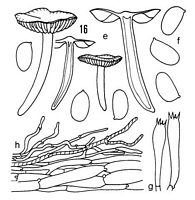
Caption: Hygrocybe cavipes Hk. (type): e. carpophores. - f spores. – g. basidia. - h. cuticle | 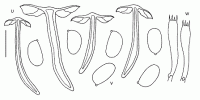
Caption: Fig 14 Hygrocybe cavipes Horak. (U-W: PDD 27082, type): U. basidiomes.
V. spores. W. basidia. | 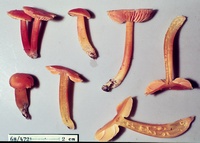
Caption: ZT68-472 , Holotype
Owner: E. Horak: © Creative Commons Attribution-Noncommercial 3.0 New Zealand | 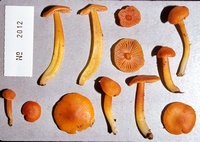
Caption: ZT2012
Owner: E. Horak: © Creative Commons Attribution-Noncommercial 3.0 New Zealand | 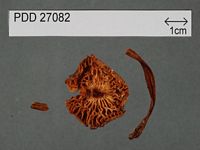
Caption: Dried type specimen
Owner: Herb PDD |
Article: Horak, E. (1990). Monograph of the New Zealand Hygrophoraceae (Agaricales). New Zealand Journal of Botany 28(3): 255-306 (http://www.rsnz.org/publish/abstracts.php).
Description: Pileus ~ 5 mm, convex to subcampanulate or broadly umbonate later becoming
expanded with subdepressed centre; yellow(-red) to brilliant orange-red; viscid,
smooth to minutely fibrillose, hygrophanous, margin striate. - Lamellae 18-26
(1 -3) adnate to emarginate-adnexed, ventricose; yellow to orange-red, edges
concolorous, entire or crenulate. - Stipe 25 - 60 x 4 -10 mm, subfusoid or cylindrical
with attenuating base, occasionally subclavate; orange to orange-red, gradually
paler or yellowish-grey-whitish towards base; viscid in wet condition, dry minutely
fibrillose, hollow, fragile, often compressed, single or caespitose. - Context
reddish-orange, yellowish to whitish in base of stipe, brittle. - Odour and
taste not distinctive. - Chemical reactions on pileus: KOH, HCI, and NH3
- negative.
Spores 7-10 x 4.5-5.5 um, ellipsoid. -Basidia 35 -45 x 7-8 um, 4-spored. -
Cystidia absent. - Pileipellis an ixocutis of cylindrical, strongly gelatinised
hyphae (3-6 um diam.), with pale yellow (KOH) plasmatic pigment; clamp connections
present (Pl. 1, Fig. 7).
Habitat: ECOLOGY: Scattered; saprobic on soil among litter predominantly under Leptospermum
and Kunzea (with Sphagnum) and in broadleaved-conifer forests.
March-May.
Distribution: DISTRIBUTION: NZ (NA, N).
Article: Horak, E. (1973). Fungi Agaricini Novazelandiae I-V. Beihefte zur Nova Hedwigia 43: 200 p.
Description: Pileus 20-45 mm diam., convex later becoming broadly umbonate or concave. red-yellow to deep orange-red, viscid, with minute radially arranged concolorous fibrils, margin striated. Lamellae emarginate-adnexed to adnate, varying from yellow to red-orange, gill edge crenulate, concolorous, ventricose. Stipe 25-60 x 4-10 mm, cylindric or attenuated towards the base, red-orange, paler towards the base to yellowish-grey, fibrillose, viscid, hollow, fragile. Context reddish-orange. Odor and taste not distinctive. Chemical reactions on pileus: KOH, NH3 and HCl - negative.
Spores 7.5-10 x 5-5.5 µm, ellipsoid, smooth, inamyloid. Basidia 35-40 x 7-8 µm, 4-spored. Cystidia absent. Cuticle consisting of erect, cylindric, strongly, gelatinized hyphae (3-6 µm diam.) forming a palisade, subcutis of cylindric hyphae 5-90 µm diam. Clamp connections present.
Habitat: In soil under Leptospermum scoparium and L. ericoides. New Zealand.
Notes: H. cavipes shows some affinities with the European H. intermedia (Pass.) and H. elegans Hk. from New Zealand, but is clearly distinguished from the two taxa by its microscopical characters.
|